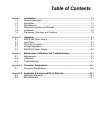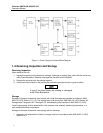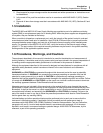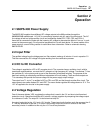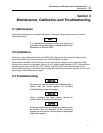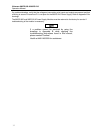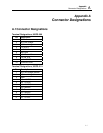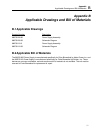
Operation
960PS-200 Power Supply
2
2-1
Section 2
Operation
2.1 960PS-200 Power Supply
The 960PS-200 supplies three different DC voltage outputs to the 960 modules through the
960MB/961MB motherboard. 115 VAC is connected to terminal strip A3, part of the front panel. The AC
line voltage is fed to a bridge rectifier circuit and rectified
by diodes CR1, CR2, CR3, and CR4. A
thermistor is connected in series with the incoming AC voltage to decrease the effect of "turn-on" in-rush
current to the power supply. For all practical purposes this is a soft start device. On some models of the
power supply a current limiting resistor is used rather than a thermistor. Refer to schematic drawing
960PS-200-53
2.2 Input Filter
The rectified voltage from the bridge goes to a filter network made up of inductor L1 and a capacitor C1.
This filter removes the DC voltage line ripple resulting from the rectification process.
2.3 DC to DC Converter
The voltage is supplied to a DC to DC converter circuit. The converter has an oscillator circuit, with its
transformer and transistors, converts the DC voltage to a high frequency AC voltage. Transformer T1 has
the oscillator Q1 in the primary and as part of the secondary a feed back winding. The purpose of the
feed back winding is maintaining oscillations independent of circuit loading. There are three outputs on
T1's secondary that provide the source voltage for the power supply output voltage.
The output from T1 at pin 7 is rectified to DC by CR1 and CR2 and fed through another filter circuit. The
output goes to two zener diodes VR1 and VR2. The zener diodes regulate the voltage down to 15 V. The
15 V is supplied to the circuits in the power supply.
2.4 Voltage Regulation
One of the zener diodes, VR2, regulates the voltage that is used in the 5 V and short circuit/overload
protection circuit. Operational amplifier AR1 acts as a voltage regulator by comparing the voltage output
to a reference 5 volts. The output 5 V is fed to terminal strip A3.
An output is also fed to the -15 V and +15 V circuits. These two circuits function much the same as the +5
V. The only difference is that the +5 V circuit is the primary output circuit and it controls all the other
secondary circuits. In addition to this only the +5 V circuit has protection.





